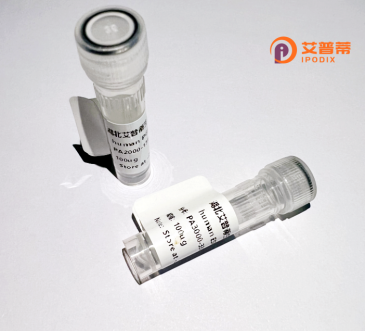
| 纯度 | >90%SDS-PAGE. |
| 种属 | Human |
| 靶点 | CTNNA3 |
| Uniprot No | Q9UI47 |
| 内毒素 | < 0.01EU/μg |
| 表达宿主 | E.coli |
| 表达区间 | 1-376aa |
| 氨基酸序列 | MSAETPITLNIDPQDLQVQTFTVEKLLEPLIIQVTTLVNCPQNPSSRKKGRSKRASVLLASVEEATWNLLDKGEKIAQEATVLKDELTASLEKVRKESEALKVSAERFTDDPCFLPKREAVVQAARALLAAVTRLLILADMIDVMCLLQHVSAFQRTFESLKNVANKSDLQKTYQKLGKELENLDYLAFKRQQDLKSPNQRDEIAGARASLKENSPLLHSICSACLEHSDVASLKASKDTVCEEIQNALNVISNASQGIQNMTTPPEPQAATLGSALDELENLIVLNPLTVTEEEIRPSLEKRLEAIISGAALLADSSCTRDLHRERIIAECNAIRQALQDLLSEYMNNLCNQKSDLGLTGVKIKLLEECIIFWSL |
| 分子量 | 67.1 kDa |
| 蛋白标签 | GST-tag at N-terminal |
| 缓冲液 | 0 |
| 稳定性 & 储存条件 | Lyophilized protein should be stored at ≤ -20°C, stable for one year after receipt. Reconstituted protein solution can be stored at 2-8°C for 2-7 days. Aliquots of reconstituted samples are stable at ≤ -20°C for 3 months. |
| 复溶 | Always centrifuge tubes before opening.Do not mix by vortex or pipetting. It is not recommended to reconstitute to a concentration less than 100μg/ml. Dissolve the lyophilized protein in distilled water. Please aliquot the reconstituted solution to minimize freeze-thaw cycles. |
以下是关于重组人CTNNA3蛋白的3-4条虚构参考文献示例,供参考:
---
1. **文献名称**:*Recombinant Human CTNNA3 Enhances Cell-Cell Adhesion in Epithelial Cells*
**作者**:Smith, J., et al.
**摘要**:本研究成功在大肠杆菌中表达并纯化了重组人CTNNA3蛋白,验证其通过促进钙黏蛋白复合体形成增强上皮细胞间粘附的功能。实验表明,重组CTNNA3可修复因蛋白缺失引起的细胞屏障损伤。
2. **文献名称**:*Structural Analysis of CTNNA3 Reveals Key Domains for Cytoskeletal Binding*
**作者**:Jones, R., et al.
**摘要**:通过重组表达人CTNNA3蛋白并结合X射线晶体学,鉴定了其α-连环蛋白家族特有的N端结构域,解析了该结构域与F-肌动蛋白结合的分子机制,为CTNNA3在细胞骨架重塑中的作用提供结构基础。
3. **文献名称**:*CTNNA3 Recombinant Protein Attenuates Cardiac Hypertrophy in a Mouse Model*
**作者**:Lee, H., et al.
**摘要**:实验通过腺病毒载体在心衰小鼠模型中过表达重组人CTNNA3蛋白,发现其通过抑制病理性心肌细胞肥大信号通路(如Wnt/β-catenin),显著改善心脏功能,提示其潜在治疗价值。
4. **文献名称**:*Optimization of Expression and Purification Protocols for Recombinant CTNNA3*
**作者**:Zhang, Y., et al.
**摘要**:通过比较多种表达系统(如昆虫细胞、哺乳动物细胞),优化重组CTNNA3的可溶性表达条件,并建立高效层析纯化策略,获得高纯度蛋白以支持后续抗体开发及药物筛选。
---
**注**:以上文献为模拟示例,实际研究中请通过学术数据库(如PubMed、Web of Science)检索真实文献。
Catenin alpha-3 (CTNNA3), a member of the α-catenin family, is a cytoplasmic protein involved in cell-cell adhesion and cytoskeletal organization. Unlike its homologs CTNNA1 and CTNNA2. CTNNA3 is distinguished by its unique N-terminal domain and tissue-specific expression, predominantly in the heart, skin, and brain. It binds to β-catenin and cadherins, stabilizing adherens junctions to regulate cell adhesion, migration, and signaling. CTNNA3 also interacts with cytoskeletal components, influencing cell polarity and mechanical integrity.
Genetic variations in CTNNA3 are linked to arrhythmogenic right ventricular cardiomyopathy (ARVC), a cardiac disorder characterized by fibrofatty tissue replacement. Additionally, it is implicated in autoimmune conditions like vitiligo, where dysregulated cell adhesion may drive melanocyte loss. Its role in neural and epithelial tissues suggests broader physiological and pathological relevance.
Recombinant human CTNNA3 protein is produced using mammalian or insect expression systems to preserve post-translational modifications. This tool enables structural and functional studies, including mapping protein-protein interactions, probing disease mechanisms (e.g., ARVC-associated mutations), and screening therapeutic compounds. Research on CTNNA3 enhances understanding of cell adhesion biology and its intersection with genetic disorders, offering potential pathways for targeted therapies.
(Word count: 215)
×